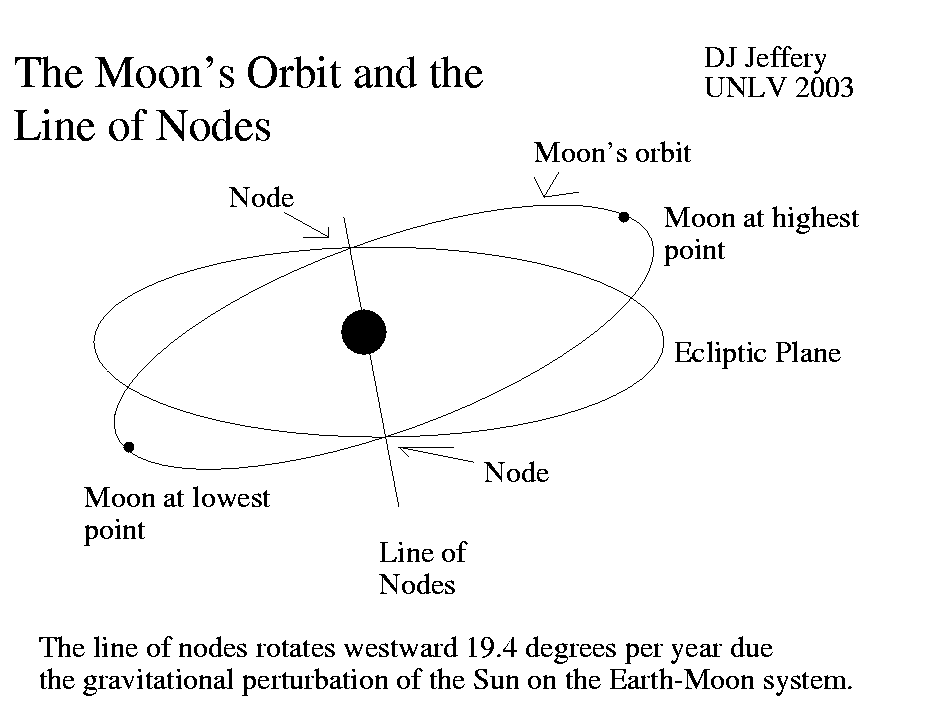
Caption: A perspective not-to-scale diagram of the Moon's orbit, lunar nodes, and the lunar node line which sets the eclipse seasons.
Features:
- Moon's orbit
has an inclination to ecliptic
of 5.145°
(see Wikipedia: Moon: Table).
Thus the Moon's orbit
crosses the
ecliptic plane
in only two places called
lunar nodes
which are the Moon-specific name
for orbital nodes
The line that connects the lunar nodes (and which passes necessarily through the Earth) is called---very imaginatively---the lunar node line (or lunar line of nodes).
- The lunar node line
rotates westward 19.3549
degrees per
Julian year (Jyr)
(see Wikipedia:
Orbit of the Moon: Inclination,
J2000 epoch???)
relative to the
observable universe.
Note that due to the rotation of the lunar node line, the time for the Moon to return to a lunar node is shorter than the sidereal month (27.321661554 days: J2000). This period is called draconic month (27.212220815 days: J2000 (see Wikipedia: Lunar month: Cycle lengths). Actually, there are 5 lunar month types and a full understanding of them is rather difficult (see Wikipedia: Lunar month: Types of lunar month).
- Now I know what you are thinking.
Why, why must the lunar node line ROTATE?
An exact gravitational two-body system, would NOT exhibit rotation of the node line relative to the observable universe.
But the Earth-Moon system is a gravitational two-body system only to 1st order. So the orbits of Earth and Moon about their mutual center of mass (which is the origin for their center-of-mass inertial frame: i.e., their inertial frame which is free-fall frame unrotating with respect to the observable universe) are simple only to 1st order.
The Sun and to a much lesser degree the planets add complicated astronomical perturbations to the Earth-Moon system. This results in subtler, complex motions.
We will, of course, NOT go into the celestial mechanics of those subtle motions. But there seems to be an endless regression of them. Once you've detected and analyzed one, there is another smaller, more subtle one to deal with. Yours truly's patience quickly runs out.
- Eclipses can only happen
when the lunar node line
is approximately aligned with the
Earth-Sun line.
The exact alignment occurs every 173.31 days
and the time frame around exact alignment
when eclipses can happen is 31 to 37 days
(see Wikipedia: Eclipse season: Details).
This time frame is called the eclipse season or, as yours truly often says, a nodal alginment---it trips off the tongue.
- Why every 173.31 days?
- If counterfactually the
lunar node line was fixed
relative to the observable universe,
exact nodal alginment would occur twice per
sidereal year
(rather precisely 365.256363004 days
(J2000)):
i.e., would occur approximately every 182.63 days.
- However, aforesaid
westward
rotation of the
lunar node line
reduces the time between
eclipse seasons
to the aforesaid 173.31 days
(see Wikipedia: Eclipse season: Details).
- Because of the rotation of the
lunar node line,
the eclipse season eventually cycles through
the whole calendar year,
and so eclipses can happen
at any time in the calendar year.
Usually, there are only 2 eclipse seasons in a calendar year, but 3 will happen if the first one occurs early enough in the calendar year.
Image link: Itself.
Local file: local link: moon_node_line.html.
File: Moon diagram file: moon_node_line.html.